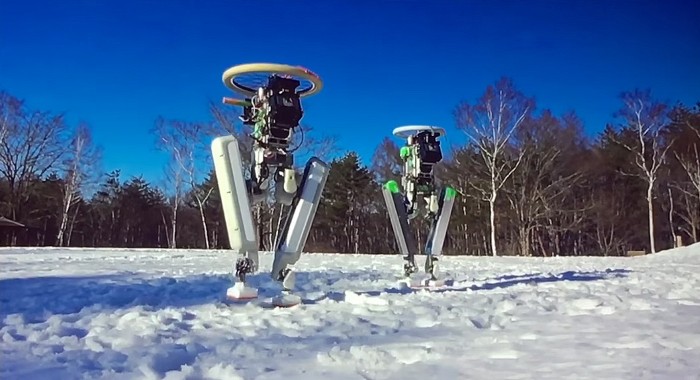An Impressive Walking Google Robot Tries to Vacuum the Stairs
These strange-looking, two-legged robots might be the predecessor of a machine that someday helps with chores around the home.
The bipedal bot, which has yet to be named, was developed by Schaft, a Japanese robotics company that is part of X, the research lab owned by Alphabet (previously Google). It was revealed at an event in Japan hosted by Andy Rubin, who started Google’s robotics project before leaving the company at the end of 2014 to create his own hardware incubator.

A video shot by someone at the event shows the robot carrying a heavy-looking gym weight, slipping on a tube without falling over, and cleaning a set of stairs with a vacuum cleaner brush attachment on its feet. It can also be seen walking through a forest and along a rocky beach.
It looks like the robot’s low center of gravity might help with its dynamic balancing. Usually such robots are very power-hungry, so it would be interesting to know how much that helps with power consumption.
The demo is especially interesting in light of Alphabet’s decision to sell off another robotics company, Boston Dynamics, that's working on walking robots. Perhaps the fact that Schaft’s robot is seen doing housework is a sign that Alphabet thinks it can commercialize the company’s technology sooner.
Schaft was spun out of the JSK Robotics Laboratory at the University of Tokyo, and one of the company’s robots took part in the first stage of DARPA’s Robotic Challenge. In fact, Schaft’s robot dominated the competition, demonstrating remarkable control, dynamic balance, and power-efficiency. But it was withdrawn by Google from the second stage of the contest for undisclosed reasons.
(Sources:"A Transformer Wins DARPA’s $2 Million Robotics Challenge," "Google Hasn’t Given Up on Robots")
Keep Reading
Most Popular
Large language models can do jaw-dropping things. But nobody knows exactly why.
And that's a problem. Figuring it out is one of the biggest scientific puzzles of our time and a crucial step towards controlling more powerful future models.
The problem with plug-in hybrids? Their drivers.
Plug-in hybrids are often sold as a transition to EVs, but new data from Europe shows we’re still underestimating the emissions they produce.
Google DeepMind’s new generative model makes Super Mario–like games from scratch
Genie learns how to control games by watching hours and hours of video. It could help train next-gen robots too.
How scientists traced a mysterious covid case back to six toilets
When wastewater surveillance turns into a hunt for a single infected individual, the ethics get tricky.
Stay connected
Get the latest updates from
MIT Technology Review
Discover special offers, top stories, upcoming events, and more.